Summary of Frank O’Hara
O'Hara was the "poet laureate" of the Abstract Expressionist movement. He was a leading figure within the new generation of New York poets, but his talent and influence extended beyond free verse into art criticism and curatorship. O'Hara was at the forefront of the rise of the American avant-garde, helping elevate Abstract Expressionism, and, indeed, New York City, to the summit of the international art world. A dashing and charismatic figure, O'Hara formed part of the troupe of hard-drinking artists, poets, and folk musicians, who hung out at the Cedar Tavern; the rundown bar that became the epicenter of the legendary 1950s art scene.
Accomplishments
- O'Hara was, in the words of the Poetry Foundation, "a dynamic leader of The New York School of poets". Closely connected to the New York School of artists (the Abstract Expressionists), they were a coterie of poets whose poems were renowned for their modishness and sharp humor. There was an added spontaneity to O'Hara's writing, as evidenced in his famous "lunch Poems" - so-called because he penned them during his lunch breaks while working at the Museum of Modern Art (MoMA).
- The respect reserved for O'Hara by his artist friends was evidenced in the number of works either featuring him or dedicated to him (following his tragic death aged just forty). He was the subject of portraits by figures of the stature of Larry Rivers, Alice Neel, Elaine de Kooning, and Alex Katz. Jasper Johns, meanwhile, titled his abstract painting, in Memory of My Feelings (1961), after an O'Hara poem. As the historian Alina Cohen notes, "these artist's diverse styles, from figuration to gestural abstraction, reveal the poet's widespread influence and the broadness of his social circle".
- Through his art criticism, O'Hara championed the careers of many Abstract Expressionists in essays for publications such as Art News magazine. He also wrote an influential monograph on Jackson Pollock (a generous act seeing as he was often on the receiving end of the artist's homophobic insults). Commenting on his "impressionistic" art criticism, the author Marjorie Perloff said of O'Hara that "like [Ezra] Pound, he had an unerring eye for genius, an amazing sense of the difference between the first-rate and the second-best".
- In addition to his poems and criticism, O'Hara contributed to the rise of Abstract Expressionism through his role as Associate Curator of Painting and Sculpture at MoMA. He helped plan and execute important retrospectives on the likes of Robert Motherwell and Franz Kline (as-well-as other modernists such as the Surrealists René Magritte and Yves Tanguy) with his greatest contribution to the movement coming with "The New American Painting" exhibition of 1958. The exhibition, which toured eight European cities, showcased works by Pollock, Rothko, de Kooning, Kline and Motherwell.
The Life of Frank O’Hara
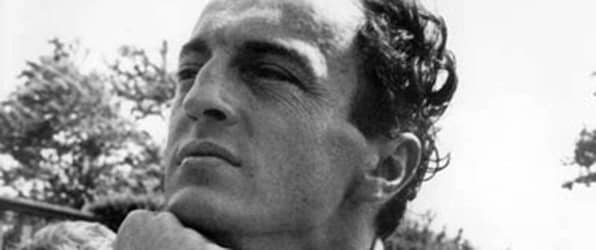
O'Hara brought a poetic elegance to art criticism: "Underlying, and indeed burgeoning within, every great work of Abstract Expressionists", he once wrote, "[there] exists the traumatic consciousness of emergency and crises experienced as personal event".
Frank O’Hara and Important Artists and Artworks
Woman I (1950-52)
The first of Willem de Kooning's Woman paintings, this work is in the Abstract Expressionist style of which the artist was a leader. Using broad, gestural brushstrokes and thickly applied paint, de Kooning renders the form of a woman who has enlarged breasts and an intense, scowling expression. The painting was certainly controversial. According to New York's Museum of Modern Art (MoMA), "some saw the painting as a betrayal, a regression to an outmoded figurative tradition. Others have called it misogynistic, understanding it as objectifying and violent. De Kooning himself said, however, 'Beauty becomes petulant to me, I like the grotesque. It's more joyous'".
O'Hara was a great champion of de Kooning's work and argued that his Woman series was profoundly important. According to author Marjorie Perloff, O'Hara thought that with de Kooning, "man and nature have become one [and that] in his female figures, we perceive structures of classical severity: the implacable identifications of man with nature. This is not symbolized. It is painted [...] The implication is that in Abstract Expressionist art, 'nature' is absorbed into painting so fully that the canvas presents a perfect union of the two".
For O'Hara this is never clearer than in de Kooning's representations of women. The author Andrew Epstein writes, "de Kooning was more than merely an artist O'Hara admired. The painter's work - especially its fresh, intoxicating mix of abstraction and figuration - also kindled O'Hara's imagination and influenced his poetry in tangible and abundant ways. This can be seen in many places in his poetry, including the poem 'Radio' [...] and his expansive 'Ode to Willem de Kooning"".
Oil and metallic paint on canvas - Museum of Modern Art, New York, New York
White Light (1954)
Completed in 1954 (two years before his death) White Light was one of Pollock's last paintings, and the only one he completed that year. Pollock squeezed paint from his tube onto the canvas and "sculpted" his black and white twists and curls of paint. He then used a brush to paint/create a background marbling effect.
Despite the fact that Pollock and O'Hara were not on especially friendly terms (Pollock was notoriously quick tempered and was given to make homophobic slurs), O'Hara was a still strong advocate of his art. He wrote a monograph on the artist in 1959 and included articles and poems about him for his "Art Chronicles" series. In his critical writings, he managed to capture the essence of Pollock's work, including this painting, and helped others to understand what the artist was trying to communicate through his works. As Perloff explains, O'Hara's comments proved "very valuable in that they force the reader to take another look at the canvas, to see it as if for the first time. Pollock's White Light, for example 'has a blazing, acrid, and dangerous glamor of a legendary kind, not unlike those volcanoes which are said to lure the native to the lip of the crater, and by the beauty of their writhings and the strength of their fumes, cause him to fall in'".
Oil on canvas - Museum of Modern Art, New York, New York
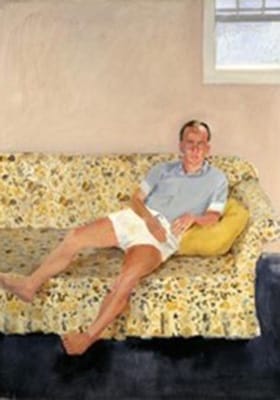
Frank O’Hara (1957)
While Frank O’Hara was the subject of other portraits by his artist friends, this painting by Fairfield Porter is the most familiar depiction of the poet. O'Hara is wearing white shorts and blue short-sleeved shirt and is reclining on a yellow floral sofa. He stares out from the canvas as if looking directly at the viewer. The manner in which Porter depicts O'Hara is typical of his figural works and, according to the Toledo Museum of Art, his, "images of family and friends [always seem to] reside in comfortable but ordinary domestic interiors".
O'Hara was a frequent visitor to Porter's home in the Hamptons. According to author Sarah E. Fensom, the house inspired his poem, "Porter Paints a Picture". Written by O'Hara for the January 1955 issue of ARTnews, Fensom states that in the poem O'Hara "describes the Henry Jamesian quality of the 'rambling white house; its many rooms invite and impose privacy to a degree.' The house, and those of the fellow artists who settled in the Hamptons during this period [...] became the hearths around which a genial artistic community congregated and flourished".
At first glance, the viewer sees a relaxed and casual O'Hara, but upon closer inspection one realizes that Porter has also succeeded in capturing a deeper insight into the poet's character. As the Toledo Museum points out, "though the pose, setting, and clothing should suggest relaxation, there is an awkwardness and a tension to the portrait that hint at the intensity of O'Hara's personality".
Oil on canvas - Toledo Museum of Art, Toledo, Ohio
Frank O’Hara (1959)
Measuring more than five feet tall, Katz's portrait of his friend is a cutout painting visible on both sides, lending it a sculptural feel. The artist felt a close affinity to the New York poets and he held a special affection for O'Hara. He thereby chose to depict him as he would have been seen in and around their bars and hangouts New York City.
Katz stated that he preferred O'Hara's works to that of the other poets because of its emotional content: "There's nothing contained. I could never do that. I don't have the courage to do what Frank did. He's the poet of my time". On a more personal level, Katz added that "even on his sixth martini - second pack of cigarettes and while calling a friend, 'a bag of shit,' and roaring off into the night, Frank's business was being an active intellectual. He was out to improve the world whether we liked it or not ... the frightening amount of energy he invested in our art and our lives often made me feel like a miser".
The admiration was mutual As Perloff explains, "in one of O'Hara's best critical essays, 'Alex Katz,' written for Art and Literature shortly before his death [...] he defines Katz's pictorial world as 'a 'void' of smoothly painted color ... where the fairly realistic figure existed (but did not rest) in a space which had no floor, no walls, no source of light, no viewpoint ... Katz's people simply existed somewhere [...] They stayed in the picture as solutions of a formal problem, neither existential nor lost [...] Certainly, Katz's 'flat' sculptural portrait of O'Hara himself [...] testifies to that sense of peculiar presence of being there that the poet speaks of".
Oil on wood (double-sided) - Robert Miller Gallery, New York, New York
Elegy to the Spanish Republic, 54 (1957-61)
The Museum of Modern Art's states that, "[Motherwell] intended his Elegies to the Spanish Republic (over 100 paintings, completed between 1948 and 1967) as a 'lamentation or funeral song' after the Spanish Civil War. His recurring motif here is a rough black oval, repeated in varying sizes and degrees of compression and distortion. Instead of appearing as holes leading into a deeper space, these light-absorbent blots stand out against a ground of relatively even, predominantly white upright rectangles. They have various associations, but Motherwell himself related them to the display of the dead bull's testicles in the Spanish bullfighting ring. Motherwell described the Elegies as his 'private insistence that a terrible death happened that should not be forgot. But,' he added, 'the pictures are also general metaphors of the contrast between life and death, and their interrelation'".
This series is just one of the many works by Motherwell that impressed O'Hara. He used his position as Associate Curator at the Museum of Modern Art to plan and mount a retrospective of the artist's work in 1965. Of the power of his paintings, O'Hara wrote, "like the rest of us, but more as an exemplar than a companion, he has his arrogant insistence on joy and his fateful cognition of the deaths around us [...] With each line, mass, and torn edge, he is, like Apelles, erecting for us the noble wall of his aspiration against the darkness without".
Oil on canvas - Museum of Modern Art, New York, New York
Frank O’Hara, 1926-1966 (1966)
One of the leading female artists of the Abstract Expressionist movement, Hartigan's painting with its vibrant colors, intense brushstrokes, and thick black lines, is characteristic of Grace Hartigan's style. The painting was produced after O'Hara's tragic death, perhaps as a way to process her loss and to celebrate his life. Author Sebastian Smee writes, this work, "is definitely an event. Measuring 6.6-by-6.6 feet, it is full of compressed energies, rhyming forms and an overall sense of energetic entanglement".
Hartigan's and O'Hara's friendship was not, however, always an easy one. At times they were the best of friends and his commemoration of her in his poetry and his art criticism helped to cement her place among the New York School of artists, a difficult "boys club" to break into. Yet, eventually this bond fell apart in part because of her desire to include figural representations in her work, something O'Hara felt was unsuccessful. Sadly, They were working on mending that friendship when O'Hara died, and perhaps Hartigan used her painting to playfully acknowledge the difficult elements of their relationship.
As the Smithsonian Museum explains, "the hot and cold colors and slashing black lines [of this work] capture the tangled emotions of their friendship and the tensions of the creative world they shared. O'Hara may have believed that painting should be purely abstract, but Hartigan had the last word. She included a figure of the poet, striding through the thicket of strokes on the canvas". That irony would not have been lost on O'Hara had he lived to witness the results.
Oil on linen - Smithsonian American Art Museum, Washington, D.C.
O'Hara Reading (1967)
Larry Rivers created paintings of his friend several times during his career. This work, however, differed from other portraits of the poet. Here Rivers has chosen to depict the artist doing what he loves, penning a work of poetry. The National Portrait Gallery states, "for his memorial portrait of O'Hara, Larry Rivers created this work, called O'Hara Reading [ ...] The piece used a characteristic technique of collage and multimedia, verbal and visual, in way that evoked his dead friend's own poetic technique. Rivers took his central image of the poet from Fred McDarrah's photograph of a 1959 reading; the black-and- white picture is colored and includes images of Leroi Jones, Allen Ginsberg, and Ray Bremser, who were also at the event. [...] Rivers created a curving stream of words caught between two blue embankments made of construction paper. In the midst of life and art's river, the print quotes the opening lines of 'To a Poet,' a work that O'Hara wrote, with characteristic generosity, to praise an emerging writer named John Wieners".
O'Hara had a complicated friendship, which sometimes involved a flirtatious element, and other times strong disagreements. However the love and appreciation for each other's work never dimmed. While one can see the affection Rivers felt for his dead friend, O'Hara himself was at the forefront of promoting Rivers's art, once stating, "his work is very much a diary of his experience [...] Where much of the art of our time has been involved with direct conceptual or ethical considerations, Rivers has chosen to mirror his preoccupations and enthusiasm in an unprogrammatic way".
Collage - National Portrait Gallery, Smithsonian Institution, Washington, D.C.
The Loading Pier (1975)
This painting is one of several in a series known as the "Killing Cycle". In these narrative works, Alfred Leslie depicts the events of the night of O'Hara's death. The series includes a depiction of the cocktail party O'Hara and others attended on that fateful evening, the nighttime accident itself, when he was hit by a beach buggy while waiting for a ride, and the aftermath as his friends wait anxiously for medical help to arrive.
Perloff said of this work, "the dead poet, dressed in a plain white T-shirt and tan trousers, lies serenely on a rectangular plank, his body showing no signs of injury. Four teen-age girls, wearing cut-off jeans and bathing suits, are carefully lowering the body from a raised platform, which floats ambiguously in midair against an empty background painted in thick browns and blacks. A young bearded man, standing toward the rear of the platform, is pulling a rope, his movements suggesting the tolling of a mourning bell. 'The painting,' wrote David Bourdon in the Village Voice, 'is in effect a modern-dress apotheosis which Leslie paints with as much drama as Renaissance painters gave to the lowering of Christ from the cross'".
Leslie's series shows the power of art as a potential vehicle for coming to terms with personal grief. According to author Graeme Reid, "Leslie turned his grief and loss into fourteen years of furious renewal and creativity. 'The Killing Cycle' is not simply a response to O'Hara's death, although six works (out of nine) in this perfectly installed show do address that issue directly [The figures in these] paintings are not the same, suggesting Leslie is concocting a story beyond what actually happened, and therein lies the crux of this body of work. Killing, taken in its broadest context, can be interpreted differently by those who were present and by those who were not".
Oil on canvas - Mildred Lane Kemper Art Museum, Washington University, St, Louis
Biography of Frank O’Hara
Childhood and Education
Francis Russell O'Hara, better known as Frank, was the first of three children born to devout Catholics, Katherine Broderick and Russell O'Hara. His birth was not without scandal as his mother was a student, eight years younger than his father- he was her English teacher at the Worchester Business Institute in Massachusetts. To avoid unwanted attention, the pair moved to Maryland where they married and where Jack was born (the newlyweds even altered O'Hara's birthdate to make it appear as if he had been conceived after their marriage). The O'Haras eventually returned to Massachusetts to help run his father's family farm.
O'Hara was close to his parents, but his mother was prone to excessive worry and anxiety attacks. According to author Brad Gooch, her "self-dramatizing tendencies would become increasingly suffocating for O'Hara, as they became increasingly random and uncontrollable". Sadly, however, O'Hara's mother's symptoms were put down to "overexertion, which he dealt with by always encouraging her to go for checkups and try vitamins, iron, and tonics". O'Hara's care for his mother meant he had to take on responsibilities for her (and his younger siblings) while he was quite young. O'Hara seemed to have enjoyed the company of his elders more than friends of his own age, and spent many hours in the company of elderly aunts who nurtured his lifelong love of reading and the movies.
O'Hara did not take to formal education and rebelled against the strict rules and routines of his Catholic school. As well as fostering his lifetime aversion to religion (a source of dismay for his practicing family), his school years saw O'Hara become aware of his sexual orientation. While he was compelled to keep his homosexuality secret, school did see him nurture an interest in music and art. According to Gooch, O'Hara "had educated himself on his own by reading books, poring over sheet music, and studying reproductions of modern paintings. His drive for knowing about all the arts was as tireless as it was unfocused, and he showed a genius, early on, for being in the know".
Early Training
Having studied piano from an early age, and with the encouragement of his parents, O'Hara began attending music classes at the New England Conservatory in Boston. O'Hara recalled, "It was a very funny life. I lived in Grafton, took a ride on a bus into Worcester every day to high school, and on Saturdays took a bus and a train to Boston to study piano. On Sundays, I stayed in my room and listened to the Sunday symphony programs". O'Hara had intended to enroll at the Conservatory on a full-time program, but the outbreak of World War II saw him sign up to the US Navy instead. He later reflected, "I was a fairly rational person who had voluntarily enlisted [rather than be drafted] in the navy and that must mean that I had subconsciously wanted to go to sea. [I thought] of how much I liked Cape Cod in the summer. For one reason: the sea".
Basic training proved something of a blessing in disguise for O'Hara. Having been sent to Key West to train as a radioman, he was given his first real taste of independent life outside his family. Having completed his training, O'Hara sailed to the South Pacific where he spent time on the U.S.S. Nicholas helping to rescue prisoners of war.
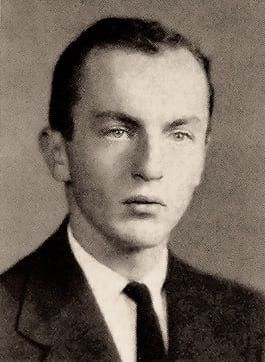
The long-term benefit of O'Hara's time in the navy came when he took advantage of the G.I. Bill of Rights. This allowed for four years of study at Harvard (financed by the federal government). O'Hara began college in the fall of 1950, and while still adjusting to his new life, he received the devastating news that his father had died suddenly. He took responsibility for his family since his mother, struggling with the loss, began drinking heavily. O'Hara tried to adopt a strategy of "tough love" but the strain of the situation caused O'Hara to suffer bouts of depression himself and, like his mother, he too sought an escape through alcohol.
Having begun as a music major, he soon changed to studying poetry and had two of his poems published in the Harvard literary magazine. College life also meant that O'Hara was freer to engage in sexual relationships. He develop many close friendships including those with roommates, artist Edward St. John Gorey and future art director Hal Fondren. While poetry was his major, O'Hara also pursued his interest in art. According to Gooch, "while shirking the required courses for which they were being graded, O'Hara and Fondren were busily attending various courses in the Art History Department that caught their fancy. O'Hara had assimilated most of the offerings of the Music and English Literature departments and was growing increasingly interested in art, evident in his readings that year of Max Ernst's Beyond Painting and Paul Klee's On Modern Art. They attended an entire series of lectures on Venetian painting at the Fogg Museum. They audited as well an introductory art appreciation course". It was at Harvard that O'Hara wrote his first poem on the topic of art. It was titled "Memorial Day 1950" and included the line "Picasso made me tough and quick". Then, following a year of graduate school at the University of Michigan, O'Hara made the move to New York City; a place he had visited several time on college breaks, and whose pull he found overpowering.
Mature Period
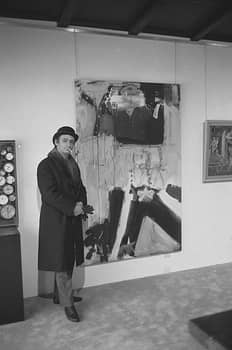
Once in New York, O'Hara forged a close friendship with the artist and poet Larry Rivers (the men having met previously at a cocktail party). While the two gay men would occasionally flirt, their relationship was thought to have remained platonic. They did, however, exert an influence on each other's work. O'Hara also formed a close friendship with artist Jane Freilicher.
Having settled in Manhattan, O'Hara began hanging out with a community of artists and poets who would become known as the New York Schools (of art and of poetry). The Poetry Foundation states that "From the beginning [of his time in New York] O'Hara's poetry was engaged with the worlds of music, dance, and painting [and in] that complex of associations he devised an idea of poetic form that allowed the inclusion of many kinds of events, including everyday conversations and notes about New York advertising signs". According to Gooch, meanwhile, "the acquaintances who most fascinated him were in the artworld [...] He began writing poems influenced by the aesthetic experiments of the painters and frequenting painters' bars such as the Cedar [Tavern]. As O'Hara's poems were always influenced by the company he was keeping, so was the direction of his life". Indeed, O'Hara was the first of the new generation New York poets to write art criticism, becoming an editorial associate for Art News, and for which, he contributed reviews and articles, between 1953-55.
O'Hara's apartment was close to the Tibor de Nagy Gallery. He became acquainted with the gallery's director, John Meyer, who introduced him to an even wider circle of artists. As Gooch explains, O'Hara's larger than life personality was matched by his appearance and he could be seen "around Rivers and around Myers's gallery, where he would often show up dressed, as Freilicher described him, in 'his dark fuzzy Shetland sweater, no shirt, chino pants and tennis shoes - Ivy League but rather exotic and chic in the N.Y. artworld in those days'".
O'Hara soon became a regular at many of New York's gay bars. His gregarious personality, and his penchant for partying and heavy drinking, also made him a good fit for the Cedar Tavern, the legendary hangout of the Abstract Expressionists. O'Hara did not, though, see eye-to-eye with Jackson Pollock whose hot temper, frequent mood swings, and homophobic outbursts, he found difficult to tolerate. O'Hara would rise above their clash of personalities, however, and the poet-cum-art critic would emerge as a major champion of Pollock's art.
For others in the group O'Hara's presence was more welcome. Current New York School poet, Andrew Epstein, wrote, "In contrast [to Pollock] de Kooning was unfailingly generous and supportive of O'Hara and his friends, who in turn idolized him and his work above all others. [...] He and his friends may have seen de Kooning as a god, but, to their delight and surprise, he was a deity who deigned to come down and chat and get drunk with mere mortals like themselves. The young poets adored de Kooning's charismatic personality, his clever wit, and his tendency (as a native speaker of Dutch rather than English) to spout wonderful off-kilter phrases and oddly poetic insights, which they would sometimes stitch into their own work". For his part, de Kooning said of O'Hara, "I liked him immediately, he was so bright. Right away he was at the center of things, and he did not bulldoze. It was his manner and his way. There was a good-omen feeling about him". O'Hara would soon begin to visit the artists' studios, penning poems about them, while they reciprocated by featuring him in portraits.
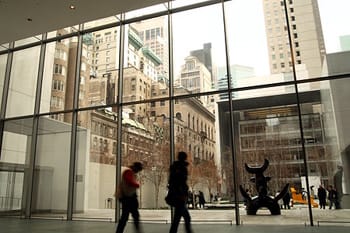
O'Hara growing presence on the New York art scene soon secured him employment within the field. His first paid job was motivated by his love of Henri Matisse, and his desire to play a small part in a major Matisse exhibition at the Museum of Modern Art (MoMA) in 1951. It was a modest start, working the front desk selling postcards and tickets. Nevertheless, it was the perfect fit for O'Hara as it meant he was able to mingle with his friends and the movers who frequented the museum.
It did not take long for O'Hara to make an impression on the museum's management, including Alfred Barr and René d'Harnoncourt, who were impressed by his knowledge of contemporary art. He would be rehired by MoMA and promoted to the position of temporary, and then permanent, Administrative Assistant in the International Program. O'Hara turned his writing skills more-and-more towards the visual art world during this period and gained growing respect for his critical voice. His friend, Fairfield Porter, recommended O'Hara to ARTnews magazine and between 1953-55 he contributed writings on artists/topics - including "Kees van Dongen", "Cubism to 1918", "Paul Klee", "Jane Freilicher", "Adolph Gottlieb" and "Fairfield Porter" - in its "Reviews and Previews" section. Also in 1955, O'Hara collaborated on a series of 26 paintings with Norman Bluhm. In what amounted to a synthesis between poetry and Action Painting, the two men alternately exchanged words and painterly gestures.
Critic Russell Ferguson writes that the idea of a New York School was "a loose concept at best", but that the poets and artists that fell under its banner did share "a self-conscious, often playful, spontaneity". Indeed, while working his day job at MoMA, O'Hara developed the habit of spending his lunch hour walking the New York streets and composing works that would become known as his "Lunch Poems". One such Poem, "A Step Away from Them" (1956), reads as follows:
"It's my lunch hour, so I go
for a walk among the hum-colored
cabs. First, down the sidewalk
where laborers feed their dirty
glistening torsos sandwiches
and Coca-Cola, with yellow helmets
on. They protect them from falling
bricks. I guess. Then onto the
avenue where skirts are flipping
above heels and blow up over
grates. The sun is hot. but the
cabs stir up the air".
According to Gooch, O'Hara had impressed his new boss in the International Program, Porter McCray, so much that, "believing O'Hara 'too brilliant and too creative' for secretarial work, he immediately gave him some important assignments. The first was to select paintings to represent the United States in the Fourth Annual Art Exhibition of Japan, which opened in Tokyo in May 1957". O'Hara, who was able to promote the work of his friends, Rivers, Grace Hartigan, Helen Frankenthaler, Michael Goldberg, and Alfred Leslie, by representing them all in the exhibition. His first solo curatorial success soon followed when he was tasked with creating the exhibition for the fourth Biennial in São Paulo in September 1957. He also started to make trips on behalf of MoMA to Europe to help with exhibitions and to meet with upcoming artists.
O'Hara's art pursuits were starting to overlap increasingly with his writing. He continued to write poems - often composed between moments of hanging with friends or in the summer months which he spent in the Hamptons homes of Porter and Rivers - and he remained highly respected within literary circles. But the influence of art on his creative writing was never far away. Indeed, the term "New York School" to which he belonged applied both to the community of East Village poets and artists.
Later Period

O'Hara's career continued to thrive in the last years of his short life. He authored a successful monograph, Jackson Pollock, published in 1959. He said of the recently deceased painter: "The scale of the painting became that of the painter's body, not the image of a body, and the setting for the scale, which would include all referents, would be the canvas surface itself. Upon this field the physical energies of the artist operate in actual detail [...] with no reference to exterior image or environment [...] no need for the mediation of metaphor or symbol. It is Action Painting".
His articles, including those in his "Art Chronicles" series, meanwhile, helped promote the work of artists such as Robert Motherwell and Claes Oldenburg, and up-and-coming artists Alex Katz and Reuben Nakian. In the summer of 1960 he visited Paris with the poet Barbara Guest. She later told how the pair arrived at the "bateau-lavoir" building where Picasso and several other of his generation had rented studios. Guest recalled, "O'Hara didn't care; he wouldn't even go inside. 'Barbara,' he said, 'that was their history and it doesn't interest me. What does interest me is ours, and we're making it now".
Between 1960-65 O'Hara assumed the role of Associate Curator at MoMA. He worked on retrospectives for Robert Motherwell and Franz Kline. But despite his continued investment in Abstract Expressionism, O'Hara warmed to emerging movements such as Pop Art and New Realism. Gooch describes how, despite being "vexed by his rise", O'Hara spoke favorably of Andy Warhol and specifically his paintings of Jacqueline Kennedy. Perloff adds that, "By the mid-60s, when the human figure began to reassert itself, O'Hara was one of the first to discern its new potential". O'Hara was also willing to embrace film and produced the text for Al Leslie's The Last Clean Shirt (1964).
In 1965 O'Hara worked on the Modern Sculpture U.S.A. exhibition, which was described in its publicity as "The largest exhibition of American sculpture ever to be shown in Europe" (it exhibited in Paris, Berlin, and Baden Baden). His series of poems written while on his lunch hours at the MoMA was published in the same year. This brought him renewed attention in literary circles, but O'Hara's personal life was less positive. While he had relationships with Joe LeSueur, and the young dancer, Vincent Warren (which went back to 1959) these were rather on/off affairs (Warren was in fact believed to have given O'Hara syphilis). His drinking also escalated, contributing to increased feelings of anxiety and bouts of depression.
O'Hara once said, "I don't ever want to grow old. I want to be like Shelley and Keats and die while I'm still young and beautiful". Regardless of whether he meant it to be taken literally of not, that statement would prove to be prophetic. In July 1966, while planning for a major de Kooning retrospective (a man he described as "the greatest painter after Picasso and Miró"), the forty-year-old O'Hara and his friend attended a cocktail party in Long Island. A taxi they were travelling in, broke down. It was the early hours of the morning and while O'Hara waited by the roadside to be collected by another car he was struck by a beach buggy. He was rushed to a nearby hospital (while William and Elaine de Kooning and René d'Harnoncourt kept vigil) but sadly died from internal injuries the following day.
The art and literary worlds of New York were rocked by O'Hara's tragic death. He was buried in the Green River Cemetery in East Hampton, New York, the same cemetery in which Pollock had been buried ten years earlier (and where O'Hara had composed his poem, Ode at the Grave of Jackson Pollock, in 1958). O'Hara's funeral was attended by the New York art world's most distinguished figures and Larry Rivers gave the eulogy in which he said of O'Hara, "he was a professional hand-holder. His fee was love. It is easy to deify in the presence of death but Frank was an extraordinary man". Philip Guston said simply, "he was our Apollinaire".
The artist Alfred Leslie produced a whole series of paintings, "The Killing Cycle", chronicling the events around O'Hara's death. As Perloff wrote, "what Leslie's painting suggests to me is that, within a decade of the poet's death, an elaborate myth had been built up, a myth centering on O'Hara as the 'laureate of the New York art scene'...". Leslie (and others) certainly helped to elevate O'Hara's through the drama of his death, but for some there is the suspicion that his death was not a tragic accident but rather a case of suicide.
The Legacy of Frank O’Hara
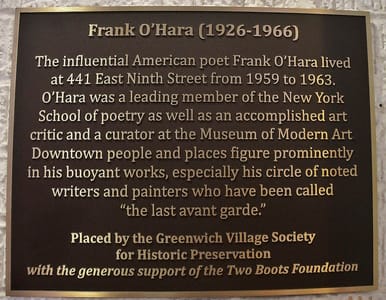
O'Hara held a place at the forefront of the first generation of New York School of Poets. The Poetry Foundation states, "Since his death in 1966 at age forty, the depth and richness of his achievements as a poet and art critic have been recognized by an international audience [...] His articulate intelligence made new proposals for poetic form possible in American poetry". The author and critic Marjorie Perloff added that, "His poetry - brilliant, droll, exciting, iconoclastic - may not measure up to the Cantos, but like [Ezra] Pound, O'Hara helped to bring about a revolution in artistic sensibility".
His writings, coupled with his key curatorial role at MoMA, meanwhile, saw him help define the Abstract Expressionist movement. As author Dan Chiasson writes, "he used the museum, as he had the Cedar [Tavern], as the backdrop for poems written on the fly, while hustling Matisse postcards or standing guard over the lines outside. Within five years, he was appointed an assistant curator, becoming an important conduit between the downtown world of gossip and brawls and the uptown world of money and museums".
Influences and Connections

-
![Guillaume Apollinaire]() Guillaume Apollinaire
Guillaume Apollinaire -
![Alfred H. Barr, Jr.]() Alfred H. Barr, Jr.
Alfred H. Barr, Jr. - René d'Harnoncourt
- John Bernard Myers
-
![Alfred H. Barr, Jr.]() Alfred H. Barr, Jr.
Alfred H. Barr, Jr. - René d'Harnoncourt
- John Bernard Myers
Useful Resources on Frank O’Hara
- City Poet: The Life and Times of Frank O’HaraOur Pickby Brad Gooch
- Frank O’Hara: Poet Among PaintersOur Pickby Marjorie Perloff
 Ask The Art Story AI
Ask The Art Story AI

















